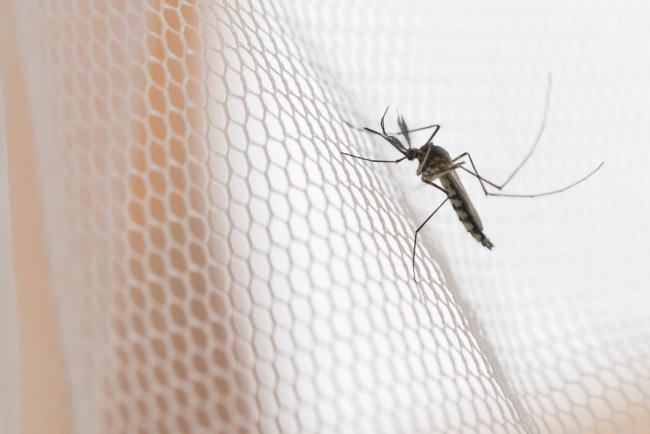Slowing malaria by treating mosquitoes
June 17, 2025
Slowing malaria by treating mosquitoes
At a Glance
- Researchers identified compounds that could kill malaria parasites inside mosquitoes.
- Incorporating these compounds into bed nets could prevent malaria transmission by mosquitoes that are resistant to insecticides.

Malaria deaths declined significantly early in the 21st century. Insecticide-treated bed nets played a large role by killing the mosquitoes that spread malaria. But this decline has stalled in recent years due to the growing resistance of mosquitoes to insecticides used in bed nets.
An alternative control strategy would be to kill the malaria parasite, Plasmodium falciparum, inside mosquitos before they can infect people. This would involve using bed nets that contain antimalarial drugs. A research team led by Drs. Dyann Wirth and Flaminia Catteruccia at the Harvard School of Public Health sought to find drugs that could work for such an approach. Results of their study, which was funded in part by NIH, appeared in Nature on May 21, 2025.
The team screened 81 antimalarial drugs by topically applying each one to live mosquitoes. Once treated, the mosquitoes were allowed to feed on Plasmodium-infected blood. Twenty-two of the drugs significantly reduced the chances of the mosquitoes getting infected. Two of the most effective drugs belonged to a class called endochin-like quinolones (ELQs). These kill malaria parasites by blocking energy production in the mitochondria.
For a drug to work in bed nets, it needs to be effective via contact with only the mosquito’s legs, the parts of the insect that come in contact with the bed net. But when tested, most of the drugs that worked in the initial screen didn’t work via contact with the legs alone. So, the researchers synthesized various ELQs to find ones that would work most effectively via contact with the legs. Two of these, ELQ-453 and ELQ-613, completely or almost completely prevented infection in mosquitoes when administered this way. Each targeted a different site on the same parasite molecule—an advantage in preventing parasites from developing resistance.
Next, the team incorporated ELQ-453 and ELQ-613 into polyethylene films similar to the material used in bed nets. Contact with these films was enough to prevent infection in mosquitoes for up to two days. Even four days after contact with the films, the chance and intensity of infection was substantially reduced. The films were still effective when tested a year later and worked on insecticide-resistant mosquitoes.
In lab studies, no parasites were able to develop resistance to both drugs. Those that had resistance to one of the drugs also had severely impaired development within mosquitoes. This would reduce the chances of transmission to humans.
These findings suggest that killing malaria parasites inside mosquitoes could be a promising approach to controlling malaria transmission to humans.
“We desperately need innovation in malaria control,” Catteruccia says. “This study offers a new, effective way to stop the transmission of malaria parasites, which we hope will reduce the burden of this devastating disease in Africa and beyond.”
However, much more work will be needed to develop and test this potential new tool’s effect on malaria transmission and disease occurrence in real-world conditions.
—by Brian Doctrow, Ph.D.
Related Links
- Potential New Target for Malaria Discovered
- Mosquitoes Use Infrared Detection to Help Find People
- Antibody Reduces Risk of Malaria in Children
- Skin Compounds Associated with Attractiveness to Mosquitoes
- Antibody Treatment Protects Adults Against Malaria
- How Mosquitoes Distinguish People from Animals
- Malaria Vaccines Provide Strong and Lasting Immunity
- Battling Bites: Blocking Mosquito-Borne Diseases
- Bitten! Mosquito-Borne Disease & You
- Malaria
References
In vivo screen of Plasmodium targets for mosquito-based malaria control. Probst AS, Paton DG, Appetecchia F, Bopp S, Adams KL, Rinvee TA, Pou S, Winter R, Du EW, Yahiya S, Vidoudez C, Singh N, Rodrigues J, Castañeda-Casado P, Tammaro C, Chen D, Godinez-Macias KP, Jaramillo JL, Poce G, Rubal MJ, Nilsen A, Winzeler EA, Baum J, Burrows JN, Riscoe MK, Wirth DF, Catteruccia F. Nature. 2025 May 21. doi: 10.1038/s41586-025-09039-2. Online ahead of print. PMID: 40399670.
Funding
NIH’s National Institute of Allergy and Infectious Diseases (NIAID); Howard Hughes Medical Institute; Open Philanthropy and Good Ventures; Fujifilm Fellowship Program; UK Research and Innovation Biotechnology and Biological Sciences Research Council; United States Department of Veterans Affairs; United States Department of Defense.


